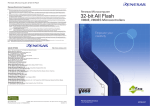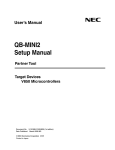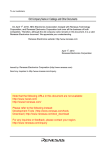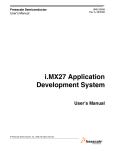Download V850E/IF3, V850E/IG3 32-bit Single
Transcript
Preliminary Application Note V850E/IF3, V850E/IG3 32-bit Single-Chip Microcontrollers Sample Programs for Serial Communication (UARTA) V850E/IF3: μPD70F3451 μPD70F3452 V850E/IG3: μPD70F3453 μPD70F3454 Document No. U18723EJ1V0AN00 (1st edition) Date Published August 2007 N 2007 Printed in Japan [MEMO] 2 Preliminary Application Note U18723EJ1V0AN NOTES FOR CMOS DEVICES 1 VOLTAGE APPLICATION WAVEFORM AT INPUT PIN Waveform distortion due to input noise or a reflected wave may cause malfunction. If the input of the CMOS device stays in the area between VIL (MAX) and VIH (MIN) due to noise, etc., the device may malfunction. Take care to prevent chattering noise from entering the device when the input level is fixed, and also in the transition period when the input level passes through the area between VIL (MAX) and VIH (MIN). 2 HANDLING OF UNUSED INPUT PINS Unconnected CMOS device inputs can be cause of malfunction. If an input pin is unconnected, it is possible that an internal input level may be generated due to noise, etc., causing malfunction. CMOS devices behave differently than Bipolar or NMOS devices. Input levels of CMOS devices must be fixed high or low by using pull-up or pull-down circuitry. Each unused pin should be connected to VDD or GND via a resistor if there is a possibility that it will be an output pin. All handling related to unused pins must be judged separately for each device and according to related specifications governing the device. 3 PRECAUTION AGAINST ESD A strong electric field, when exposed to a MOS device, can cause destruction of the gate oxide and ultimately degrade the device operation. Steps must be taken to stop generation of static electricity as much as possible, and quickly dissipate it when it has occurred. Environmental control must be adequate. When it is dry, a humidifier should be used. It is recommended to avoid using insulators that easily build up static electricity. Semiconductor devices must be stored and transported in an anti-static container, static shielding bag or conductive material. All test and measurement tools including work benches and floors should be grounded. The operator should be grounded using a wrist strap. Semiconductor devices must not be touched with bare hands. Similar precautions need to be taken for PW boards with mounted semiconductor devices. 4 STATUS BEFORE INITIALIZATION Power-on does not necessarily define the initial status of a MOS device. Immediately after the power source is turned ON, devices with reset functions have not yet been initialized. Hence, power-on does not guarantee output pin levels, I/O settings or contents of registers. A device is not initialized until the reset signal is received. A reset operation must be executed immediately after power-on for devices with reset functions. 5 POWER ON/OFF SEQUENCE In the case of a device that uses different power supplies for the internal operation and external interface, as a rule, switch on the external power supply after switching on the internal power supply. When switching the power supply off, as a rule, switch off the external power supply and then the internal power supply. Use of the reverse power on/off sequences may result in the application of an overvoltage to the internal elements of the device, causing malfunction and degradation of internal elements due to the passage of an abnormal current. The correct power on/off sequence must be judged separately for each device and according to related specifications governing the device. 6 INPUT OF SIGNAL DURING POWER OFF STATE Do not input signals or an I/O pull-up power supply while the device is not powered. The current injection that results from input of such a signal or I/O pull-up power supply may cause malfunction and the abnormal current that passes in the device at this time may cause degradation of internal elements. Input of signals during the power off state must be judged separately for each device and according to related specifications governing the device. Preliminary Application Note U18723EJ1V0AN 3 Caution: This product uses SuperFlash® technology licensed from Silicon Storage Technology, Inc. SuperFlash is a registered trademark of Silicon Storage Technology, Inc. in several countries including the United States and Japan. • The information contained in this document is being issued in advance of the production cycle for the product. The parameters for the product may change before final production or NEC Electronics Corporation, at its own discretion, may withdraw the product prior to its production. • No part of this document may be copied or reproduced in any form or by any means without the prior written consent of NEC Electronics. NEC Electronics assumes no responsibility for any errors that may appear in this document. • NEC Electronics does not assume any liability for infringement of patents, copyrights or other intellectual property rights of third parties by or arising from the use of NEC Electronics products listed in this document or any other liability arising from the use of such products. No license, express, implied or otherwise, is granted under any patents, copyrights or other intellectual property rights of NEC Electronics or others. • Descriptions of circuits, software and other related information in this document are provided for illustrative purposes in semiconductor product operation and application examples. The incorporation of these circuits, software and information in the design of a customer's equipment shall be done under the full responsibility of the customer. NEC Electronics assumes no responsibility for any losses incurred by customers or third parties arising from the use of these circuits, software and information. • While NEC Electronics endeavors to enhance the quality, reliability and safety of NEC Electronics products, customers agree and acknowledge that the possibility of defects thereof cannot be eliminated entirely. To minimize risks of damage to property or injury (including death) to persons arising from defects in NEC Electronics products, customers must incorporate sufficient safety measures in their design, such as redundancy, fire-containment and anti-failure features. • NEC Electronics products are classified into the following three quality grades: "Standard", "Special", and "Specific". The "Specific" quality grade applies only to NEC Electronics products developed based on a customer-designated "quality assurance program" for a specific application. The recommended applications of an NEC Electronics product depend on its quality grade, as indicated below. Customers must check the quality grade of each NEC Electronics products before using it in a particular application. "Standard": Computers, office equipment, communications equipment, test and measurement equipment, audio and visual equipment, home electronic appliances, machine tools, personal electronic equipment and industrial robots. "Special": Transportation equipment (automobiles, trains, ships, etc.), traffic control systems, anti-disaster systems, anti-crime systems, safety equipment and medical equipment (not specifically designed for life support). "Specific": Aircraft, aerospace equipment, submersible repeaters, nuclear reactor control systems, life support systems and medical equipment for life support, etc. The quality grade of NEC Electronics products is "Standard" unless otherwise expressly specified in NEC Electronics data sheets or data books, etc. If customers wish to use NEC Electronics products in applications not intended by NEC Electronics, they must contact an NEC Electronics sales representative in advance to determine NEC Electronics' willingness to support a given application. (Note) (1) "NEC Electronics" as used in this statement means NEC Electronics Corporation and also includes its majority-owned subsidiaries. (2) "NEC Electronics products" means any product developed or manufactured by or for NEC Electronics (as defined above). M5 02. 11-1 4 Preliminary Application Note U18723EJ1V0AN INTRODUCTION Cautions 1. This Application Note explains a case where the V850E/IG3 is used as a representative microcontroller. Use this Application Note for your reference when using the V850E/IF3. 2. Download the program used in this manual from the page of Programming Examples (http://www.necel.com/micro/en/designsupports/sampleprogram/index.html) in the NEC Electronics Website (http://www.necel.com/). 3. This sample program is provided for reference purposes only and operations are therefore not subject to guarantee by NEC Electronics Corporation. When using sample programs, customers are advised to sufficiently evaluate this product based on their systems, before use. 4. When using sample programs, reference the following startup routine and link directive file and adjust them if necessary. • Startup routine: ig3_start.s • Link directive file: ig3_link.dir Target Readers This Application Note is intended for users who understand the functions of the V850E/IF3 (μPD70F3451, 70F3452), and V850E/IG3 (μPD70F3453, 70F3454), and who design application systems that use these microcontrollers. Purpose This manual is intended to give users an understanding of the basic functions of the V850E/IF3 and V850E/IG3, using the application programs. How to Use This Manual It is assumed that the reader of this Application Note has general knowledge in the fields of electrical engineering, logic circuits, and microcontrollers. For details of hardware functions (especially register functions, setting methods, etc.) and electrical specifications → See the V850E/IF3, V850E/IG3 Hardware User’s Manual. For details of instruction functions → See the V850E1 Architecture User’s Manual. Conventions Data significance: Higher digits on the left and lower digits on the right Active low representation: xxx (overscore over pin or signal name) Memory map address: Higher addresses on the top and lower addresses on Note: Footnote for item marked with Note in the text Caution: Information requiring particular attention Remark: Supplementary information the bottom Numeric representation: Binary ... xxxx or xxxxB Decimal ... xxxx Hexadecimal ... xxxxH Prefix indicating the power of 2 (address space, memory capacity): K (kilo): 210 = 1,024 M (mega): 220 = 1,0242 G (giga): 30 3 2 = 1,024 Preliminary Application Note U18723EJ1V0AN 5 The function lists are structured as follows. Hardware name (symbol) [Function] Function description [Function name] Name of sample function [Argument(s)] Type and overview of argument(s) [Processing content] Processing content of sample function [SFR(s) used] Register name and setting content [call function(s)] Name and function of call function(s) [Variable(s)] Type, name, and overview of variable(s) used in sample function [Interrupt(s)] Name of function [Interrupt source(s)] Name [File name] Name of corresponding sample program file [Caution(s)] Caution(s) upon function usage Interrupt function [Function name] 6 Name of interrupt function [Servicing content] Servicing content of interrupt function [SFR(s) used] Name of interrupt and conditions for occurrence [call function(s)] None [Variable(s)] Name of variable, function [File name] Name of corresponding sample program file [Caution(s)] None Preliminary Application Note U18723EJ1V0AN Related Documents The related documents indicated in this publication may include preliminary versions. However, preliminary versions are not marked as such. Documents related to V850E/IF3 and V850E/IG3 Document Name Document No. V850E1 Architecture User’s Manual U14559E V850E/IF3, V850E/IG3 Hardware User’s Manual U18279E V850E/IF3, V850E/IG3 Sample Programs for Serial Communication This manual (UARTA) Application Note V850E/IF3, V850E/IG3 Sample Programs for Serial Communication To be prepared (UARTB) Application Note V850E/IF3, V850E/IG3 Sample Programs for Serial Communication (CSIB) To be prepared Application Note 2 V850E/IF3, V850E/IG3 Sample Programs for Serial Communication (I C) To be prepared Application Note V850E/IF3, V850E/IG3 Sample Programs for DMA Function Application To be prepared Note V850E/IF3, V850E/IG3 Sample Programs for Timer M Application Note To be prepared V850E/IF3, V850E/IG3 Sample Programs for Watchdog Timer Application To be prepared Note V850E/IF3, V850E/IG3 Sample Programs for Timer AA Application Note To be prepared V850E/IF3, V850E/IG3 Sample Programs for Timer AB Application Note To be prepared V850E/IF3, V850E/IG3 Sample Programs for Timer T Application Note To be prepared V850E/IF3, V850E/IG3 Sample Programs for Port Function Application Note To be prepared V850E/IF3, V850E/IG3 Sample Programs for Clock Generator Application To be prepared Note V850E/IF3, V850E/IG3 Sample Programs for Standby Function Application To be prepared Note V850E/IF3, V850E/IG3 Sample Programs for Interrupt Function Application To be prepared Note V850E/IF3, V850E/IG3 Sample Programs for A/D Converters 0 and 1 To be prepared Application Note V850E/IF3, V850E/IG3 Sample Programs for A/D Converter 2 Application To be prepared Note V850E/IF3, V850E/IG3 Sample Programs for Low-Voltage Detector (LVI) To be prepared Function Application Note V850E/IF3, V850E/IG3 6-Phase PWM Output Control by Timer AB, Timer Q U18717E Option, Timer AA, A/D Converters 0 and 1 Application Note Preliminary Application Note U18723EJ1V0AN 7 CONTENTS CHAPTER 1 CONTINUOUS TRANSMISSION/RECEPTION .................................................................. 9 8 Preliminary Application Note U18723EJ1V0AN CHAPTER 1 CONTINUOUS TRANSMISSION/RECEPTION [Function] Performs continuous UARTA0 transmission/reception. [Function name] uarta_main [Argument] None [Processing content] Performs transmission/reception for ten times using UARTA0. Stores received data in buf_rx[], and transmitted data in buf_tx[]. [SFRs used] UA0REIC: 0x07 (Clears UARTA0 reception error interrupt request signal (INTUA0RE), releases mask, sets to priority level 7.) UA0TIC: 0x07 (Clears UARTA0 transmission enable interrupt request signal (INTUA0T), releases mask, sets to priority level 7.) UA0RIC: 0x07 (Clears UARTA0 reception end interrupt request signal (INTUA0R), releases mask, sets to priority level 7.) [call functions] uarta_port_set, uarta_set, uarta_start, uarta_send_end, uarta_receive_end, uarta_end [Variables] unsigned char buf_tx[]: Transmit data storing buffer unsigned char buf_rx[]: Receive data storing buffer volatile unsigned char count_tx: Transmission count variable volatile unsigned char count_rx: Reception count variable unsigned char count: Transfer data generating variable [Interrupts] uarta_int_send, uarta_int_receive, uarta_error [Interrupt sources] INTUA0T, INTUA0R, INTUA0RE, [File name] uarta.c [Caution] None [Function name] uarta_port_set [Processing content] Sets alternate-function pin to UARTA0 I/O pin. [SFRs used] PFC4: 0x03 (Sets TXDA0 output and RXDA0 input.) PFCE4: 0x00 (Sets TXDA0 output and RXDA0 input.) PMC4: [call function] None [Variable] None [File name] uarta.c [Caution] None 0x03 (Sets TXDA0 output and RXDA0 input.) Preliminary Application Note U18723EJ1V0AN 9 CHAPTER 1 CONTINUOUS TRANSMISSION/RECEPTION [Function name] uarta_set [Processing content] Sets UARTA0 control register. Sets baud rate to 9,600 (bps). [SFRs used] UA0CTL1: 0x03 (Sets baud rate to 9,600 (bps).) UA0CTL2: 0xD0 (Sets baud rate to 9,600 (bps).) UA0OPT0: 0x14 (Sets to ordinary output of transfer data, ordinary input of transfer data.) UA0CTL0: 0x8A (Enables UARTA0 operation, sets to MSB first, and sets odd parity to output, data character length of 8 bits, and stop bit length of 1 bit.) [call function] None [Variable] None [File name] uarta.c [Caution] None [Function name] uarta_start [Processing content] Enables transmission/reception and writes data to UA0TX register. [SFRs used] UA0CTL0.UA0TXE: 1 (Enables transmission operation.) UA0CTL0.UA0RXE: 1 (Enables reception operation.) UA0TX Transmit data register [call function] None [Variables] unsigned char buf_tx[]: [File name] uarta.c [Caution] Set UA0RXE and UA0TXE bits to 1 after setting UA0CTL.UA0PWR bit to 1. [Function name] uarta_send_end [Processing content] Disables transmission operation. [SFR used] UA0CTL0.UA0TXE: 0 (Disables transmission operation.) [call function] None [Variable] None [File name] uarta.c [Caution] None 10 Transmit data storing buffer Preliminary Application Note U18723EJ1V0AN CHAPTER 1 CONTINUOUS TRANSMISSION/RECEPTION [Function name] uarta_receive_end [Processing content] Disables reception operation. [SFR used] UA0CTL0.UA0RXE: 0 (Disables reception operation.) [call function] None [Variable] None [File name] uarta.c [Caution] None [Function name] uarta_ end [Processing content] Disables operation of UARTA0. [SFR used] UA0CTL0.UA0PWR: 0 (Disables operation of UARTA0.) [call function] None [Variable] None [File name] uarta.c [Caution] None Interrupt function [Function name] uarta_int_send [Processing content] Writes transmit data to transmit data register. Stops transmission operation if number of transmissions and the count value match. [SFR used] UA0TX Transmit data register [call function] None [Variables] unsigned char buf_tx[]: Transmit data storing buffer volatile unsigned char count_tx: Transmission count variable [File name] uarta.c [Caution] None Preliminary Application Note U18723EJ1V0AN 11 CHAPTER 1 CONTINUOUS TRANSMISSION/RECEPTION [Function name] uarta_int_receive [Processing content] Writes receive data to receive data register. Stops and disables reception operation if number of receptions and the count value match. [SFR used] UA0RX Receive data register [call function] None [Variables] unsigned char buf_rx[]: Receive data storing buffer volatile unsigned char count_rx: Reception count variable [File name] uarta.c [Caution] To stop reception operation, set UA0PWR bit to 0 after setting UA0RXE and UA0TXE bits to 0. [Function name] uarta_error [Processing content] Clears error flag when reception error occurs. [SFRs used] UA0STR.UA0PE: 0 (Clears parity error flag.) UA0STR.UA0FE: 0 (Clears framing error flag.) UA0STR.UA0OVE: 0 (Clears overrun error flag.) [call function] None [Variable] None [File name] uarta.c [Caution] None 12 Preliminary Application Note U18723EJ1V0AN CHAPTER 1 CONTINUOUS TRANSMISSION/RECEPTION Figure 1-1. Continuous Transmission/Reception (1/4) uarta_main DI Disables maskable interrupt request. count_tx = 0 Initializes transmission count. count_rx = 0 Initializes reception count. uarta_port_set Alternate-function pin setting function uarta_set UARTA0 control register setting function Initializes count for transmission data generated. count = 0 Yes count>TX_SIZE Checks count for transmission data generated. No buf_tx[count] = count + 1 Substitutes value in buf_tx[] Increments count for transmission data generated. count++ UA0REIC = 0x07 Clears INTUA0RE interrupt request signal, releases mask, sets to priority level 7. UA0TIC = 0x07 Clears INTUA0T interrupt request signal, releases mask, sets to priority level 7. UA0RIC = 0x07 Clears INTUA0R interrupt request signal, releases mask, sets to priority level 7. EI uarta_start Enables maskable interrupt request. UARTA0 operation start function A Preliminary Application Note U18723EJ1V0AN 13 CHAPTER 1 CONTINUOUS TRANSMISSION/RECEPTION Figure 1-1. Continuous Transmission/Reception (2/4) A count_rx>=RX_SIZE No Checks reception count. Yes uarta_receive_end count_tx>TX_SIZE UARTA0 reception operation disable function No Checks transmission count. Yes uarta_send_end count_rx >= RX_SIZE && UARTA0 transmission operation disable function No Checks reception and transmission count. count_tx > TX_SIZE Yes uarta_end 14 UARTA0 operation disable function Preliminary Application Note U18723EJ1V0AN CHAPTER 1 CONTINUOUS TRANSMISSION/RECEPTION Figure 1-1. Continuous Transmission/Reception (3/4) Alternate function pin setting function UARTA0 control register setting function uarta_port_set uarta_set PFC4 = 0x03 PFCE4 = 0x00 PMC4 = 0x03 Sets alternate-function pin to TXDA0 output and RXDA0 input. UA0CTL1 = 0x03 Sets baud rate to 9,600 bps. UA0CTL2 = 0xD0 ret UARTA0 operation start function UA0OPT0 = 0x14 Outputs transfer data normally. Inputs transfer data normally. UA0CTL0 = 0x8A Enables UARTA0 operation. Sets transfer direction to MSB first. Sets parity selection to odd parity. Sets data length to 8 bits. Sets stop bit to 1 bit. uarta_start UA0TXE = 1 Enables transmission operation. UA0RXE = 1 Enables reception operation. ret UARTA0 transmission operation disable function WAIT UA0TX = buf_tx[0] uarta_send_end Needs to weight over 2 × fUCLK. Writes to UA0TX register. UARTA0 reception operation disable function UARTA0 operation disable function uarta_end uarta_receive_end ret Disables transmission operation. ret ret UA0RXE = 0 UA0TXE = 0 UA0PWR = 0 Disables reception operation. Disables UARTA0 operation. ret Preliminary Application Note U18723EJ1V0AN 15 CHAPTER 1 CONTINUOUS TRANSMISSION/RECEPTION Figure 1-1. Continuous Transmission/Reception (4/4) INTUA0T interrupt INTUA0T interrupt function uarta_int_send No count tx<TX SIZE Checks transmission count. Yes UA0TX = buf_fx[count_tx] Writes to UA0TX register. count_tx++ Increments transmission count. Increments transmission count. count_tx++ reti INTUA0RE interrupt INTUA0R interrupt INTUA0RE error interrupt function INTUA0R interrupt function uarta_error uarta_int_receive buf_rx[count_rx] = UA0RX count_rx++ reti Stores reception result. Increments reception count. UA0PE = 0 Clears parity error flag. UA0FE = 0 Clears framing error flag. UA0OVE = 0 reti 16 Preliminary Application Note U18723EJ1V0AN Clears overrun error flag. For further information, please contact: NEC Electronics Corporation 1753, Shimonumabe, Nakahara-ku, Kawasaki, Kanagawa 211-8668, Japan Tel: 044-435-5111 http://www.necel.com/ [America] [Europe] [Asia & Oceania] NEC Electronics America, Inc. 2880 Scott Blvd. Santa Clara, CA 95050-2554, U.S.A. Tel: 408-588-6000 800-366-9782 http://www.am.necel.com/ NEC Electronics (Europe) GmbH Arcadiastrasse 10 40472 Düsseldorf, Germany Tel: 0211-65030 http://www.eu.necel.com/ NEC Electronics (China) Co., Ltd 7th Floor, Quantum Plaza, No. 27 ZhiChunLu Haidian District, Beijing 100083, P.R.China Tel: 010-8235-1155 http://www.cn.necel.com/ Hanover Office Podbielskistrasse 166 B 30177 Hannover Tel: 0 511 33 40 2-0 Munich Office Werner-Eckert-Strasse 9 81829 München Tel: 0 89 92 10 03-0 Stuttgart Office Industriestrasse 3 70565 Stuttgart Tel: 0 711 99 01 0-0 United Kingdom Branch Cygnus House, Sunrise Parkway Linford Wood, Milton Keynes MK14 6NP, U.K. Tel: 01908-691-133 Succursale Française 9, rue Paul Dautier, B.P. 52 78142 Velizy-Villacoublay Cédex France Tel: 01-3067-5800 Sucursal en España Juan Esplandiu, 15 28007 Madrid, Spain Tel: 091-504-2787 Tyskland Filial Täby Centrum Entrance S (7th floor) 18322 Täby, Sweden Tel: 08 638 72 00 Filiale Italiana Via Fabio Filzi, 25/A 20124 Milano, Italy Tel: 02-667541 Shanghai Branch Room 2509-2510, Bank of China Tower, 200 Yincheng Road Central, Pudong New Area, Shanghai, P.R.China P.C:200120 Tel:021-5888-5400 http://www.cn.necel.com/ Shenzhen Branch Unit 01, 39/F, Excellence Times Square Building, No. 4068 Yi Tian Road, Futian District, Shenzhen, P.R.China P.C:518048 Tel:0755-8282-9800 http://www.cn.necel.com/ NEC Electronics Hong Kong Ltd. Unit 1601-1613, 16/F., Tower 2, Grand Century Place, 193 Prince Edward Road West, Mongkok, Kowloon, Hong Kong Tel: 2886-9318 http://www.hk.necel.com/ NEC Electronics Taiwan Ltd. 7F, No. 363 Fu Shing North Road Taipei, Taiwan, R. O. C. Tel: 02-8175-9600 http://www.tw.necel.com/ NEC Electronics Singapore Pte. Ltd. 238A Thomson Road, #12-08 Novena Square, Singapore 307684 Tel: 6253-8311 http://www.sg.necel.com/ NEC Electronics Korea Ltd. 11F., Samik Lavied’or Bldg., 720-2, Yeoksam-Dong, Kangnam-Ku, Seoul, 135-080, Korea Tel: 02-558-3737 http://www.kr.necel.com/ Branch The Netherlands Steijgerweg 6 5616 HS Eindhoven The Netherlands Tel: 040 265 40 10 G0706
























